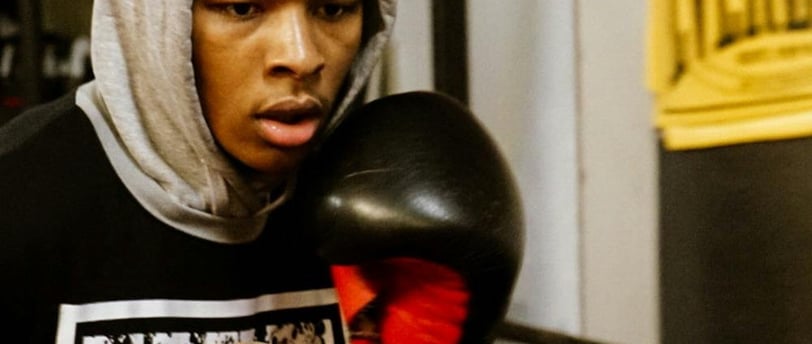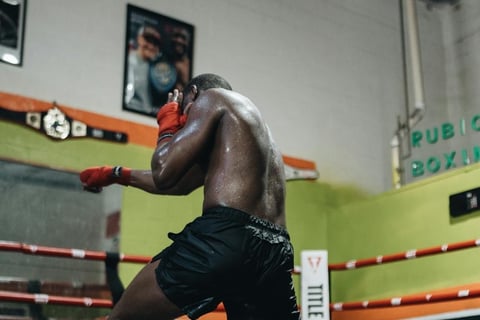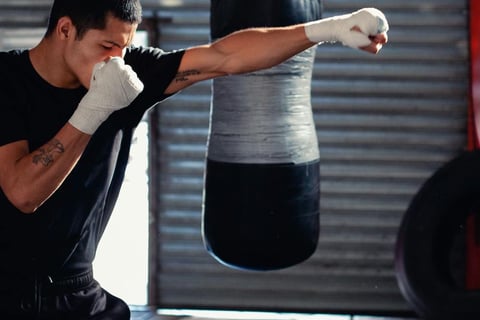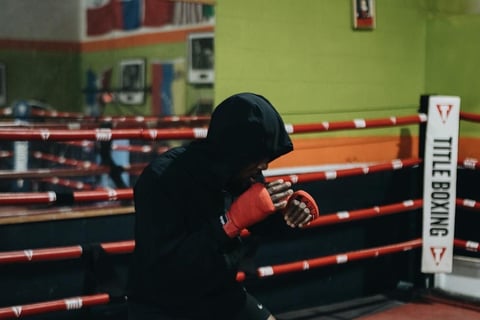jjj
7 Boxing Combos For Beginners
Learn to throw some essential combos that are resourceful to a developing boxer.
5/18/20259 min read


Table Of Contents:
Why Combos Matter
7 Essential Combos For Beginners
Common Mistakes To Avoid
Drills to Practice Combos
Understanding Timing & Distance
The Role Of Footwork In Combos
Why Combos Matter
Understanding how to effectively time and setup combos should be grounded in the initial roots of learning to build on foundation as a boxer. Simply put, a combination in boxing is just a sequence comprised of various strikes placed in specific positions. Combinations are used to encourage advantageous shots and movements. In reference to the beginner boxer, combination training should be among prioritized areas of focus as someone intending to hone their skills. If you dedicate serious focus to capitalizing in this area, then you’ll notice impactful improvements that will translate positively in general and in the ring.
Additionally, perfecting your combinations capitalizes on incorporating balanced-movements and positioning against your opposer. Effectively executing your combos can establish better positioning for you in the ring as it can expose potential weaknesses as you make various moves against your opponent while blending IQ. The more you adapt to different attacking sequences the more dominance you can create on offense as a fighter
Consequently, as a result of building your combination arsenal, you’ll notice the increased awareness regarding your judgement and timing against your rival. You will be more attentive to exposures that can be exploited through well-timed counters and positioning of punches. You’ll also be able to efficiently use feints to sway momentum in your favor to land more shots. So, be sure to remain aware of each detail regarding your various strikes in practice so that you’ll be a step ahead in the ring.
Lastly, perfecting your combination skills in training will ultimately benefit your competency overall as a fighter because it delegates attention to smaller details like finding exposed areas which was mentioned earlier. Be sure to emphasize meaningful repetition when attentiveness. You can improve on this aspect simply by shadowboxing alone if using proper procedures of approach.
7 Basic Combinations for Novices
As mentioned above, it is imperative to be able to select and throw impactful blows that create some type of hinderance for your opponent or else you’re leaving yourself susceptible to receiving that much more punishment. So, to establish greater dominance as beginner boxer, I’ll list a few different basic combos to work on with sample videos to visualize better.
(1-2)/Jab-Cross: This two-punch combo is essentially initiated by launching the lead hand straightforward, followed by straight rear hand. Typically, the jab will be used to set up the more powerful cross (many alternatives to capitalize) since jabs can be used to find range, open up guards, temporarily “blind” the opponent, etc..
Combo demonstration below (can expand bottom icon to enlarge)
(1-2-3) Jab-Cross-Hook: This combo ultimately adds off the last previous by adding one more strike. Start by using the lead jab, then unload with a straight rear once again before pivoting off the lead foot to quickly throw a lead hook around the guard of opponent. Adding the hook can surprise the opposer as it will be coming from the side when timed properly.
3. (6-3) Rear Upper-Lead Hook: Strike with the rear hand using an uppercut to lower the guard before unloading a lead hook up top on to your opponent’s head. This move is good for making opposer drop their hands when well-timed.
4. (1-3-2) Jab-Hook-Cross: Initiate with the lead jab then pivot into a lead hook while using an unsuspecting straight rear between the opponent’s guard. This setup can effectively surprise your opponent if you efficiently position yourself to execute these punches in a timely manner.
5. (2-2B) Cross-Cross (body): Unload with the cross to the head. You will follow with the same strike but instead aiming the second cross to the body. Be sure to lower your body with your punch so you aren’t leaving yourself exposed more by just dropping the hand.
6. (3-6) Lead Hook+Rear Upper: Initiate with the lead hook to the side of opposer’s head around the guard before unleashing the rear uppercut down the middle of guard. This move if timed correctly can stun your opponent.
7. (1-2-5) Jab+Cross+Lead Upper: Start with a jab to the head then a straight rear that can create an opening to land following with the lead hook. Be sure to emphasize positioning through footwork so you’re balanced as you release and not throwing your combo awkwardly.
Extra tips: A simpler way to look at combinations in boxing is to realize that each of the sequences (like the ones previously mentioned) are building blocks for beginners. So, perfecting on these combos will ultimately lead into progressive development with larger setups more effectively as you gain more experience. The more you build on these basic crafts, the better your timing, intuition, positioning, and overall striking will be as advance.
Common Errors To Evade
As many newcomers begin their initial journey of building their boxing skills, there are common mistakes that the majority of newbies might tend to make just like with most new practices as one is adjusting.
But it’s noteworthy to be aware that there’s mistakes that (if left uncorrected) can ultimately create and lead to bad habits over time.
As there are quite a few potential bad habits that can be built with lack of focus, I believe there are some commonly notable ones to address. One stronger example could be poor footwork since it correlates to overall efficiency of bodily movement. Many newcomers might tend to cross their feet while shifting, moving their feet wrong getting in/out, & with positioning as their throwing strikes. It is critical to emphasize the importance of footwork placement in association to bodily movement. Plus, it is essential to know not to remain stationary as your with the opposer’s range.
In addition, many new fighters tend to get caught up in the moment about the idea of landing hits and begin to sacrifice proper technique for sloppiness. They may tend to overreach, get stiff, poor strike selection/lower IQ shots, and more which in turns just ultimately wastes more energy and leaves you more vulnerable for being countered/exploited. It is helpful to remember in training that you are working on picking strikes that come with intention (not just hoping they land) while also being mindful of how you choose to delegate them in a way that benefits you. Basically, you should be playing your game not falling into their’s by trying to force attacks.
Also, another vital tip is to remember to keep them hands up at all times when you’re in range of opponent. Including, whenever the non-punching hand is back at the time of a strike and when the strike hand pulls straight back. In the early stages, it can be easier to forget to keep things like this in check until it becomes habit so be sure to bring repeated attention to this in training so it’ll show up in action later. It can assist to start easing into head movement drills (like slips/rolls) too, but, I would recommend getting basic blocks down more first.
Humanize AI
Drills to Master Combos
For those aiming to sharpen their boxing skills, it is largely relevant to emphasize the importance of implementing boxing drills into your training regime. A common practice to heighten your skillsets is to shadowbox. Shadowboxing is a great way to improve various aspects of your game from footwork, combos, creating angles, head movements, and more. Also, practicing this can up your conditioning skills while helping build on your foundation. The should be emphasis placed on finding your comfort zone in terms of rhythm, muscle memory and coordination. It can be more beneficial to visualize an opponent in front of you too.
Shadowboxing is a unique way to improve your skills because it can be done with no assistance or equipment, therefore, making it reliable for training practically anywhere. But for another helpful drill that can be used to increase skill you can work mitts. Working mitts can be beneficial as helps one achieve greater accuracy and more efficient timing. Also, it aids with angles and positioning coming off punches and on the defensive. A coach or training partner can help you act with more adaptability because they can call out various combinations on the fly too.
Working on the bag is going to provide useful benefits as well. Working the bag is great for increasing the power behind your punches and developing better technique as you strike. Additionally, it is a resourceful way to build conditioning which is essential your athletic performance capabilities as well. You can switch up between different combo lengths (for example: two-punch to four-punch combos) to help develop the placement of your punches and adjust to different angles or strikes.
Furthermore, another tip you could use is to practice your shadowboxing in front of a mirror of recording yourself on camera. This can be very helpful as it can give yourself opportunities to correct any noticeable mistakes or find any areas for possible improvements. Making reviewing yourself a consistent effort can ultimately prevent bad habits and unnecessary mistakes. The more prepared you are in training, the better prepared you’ll be to optimize your performance in the ring with other opponents.
Understanding the Timing and Distance Aspects
In the sport of boxing, timing and distance are two essential concepts to be cognitive of. Ultimately, timing comes down to the awareness/capability to exploit weaknesses of opponents whether that be on the offensive or defensive end. Distance refers to the ability to be aware of spacial ranges between you and your opposing contender. Clearly, these two concepts are vital to be cognizant of if you want to optimize your IQ, performance, and safety measures as a fighter.
To improve your ability to take advantage of managing distance, it is imperative to work on developing/maintaining proper footwork. Doing so will enable you to be less exposed to punches from getting countered, being unprepared/unaware or off-balance. Be cognizant of your’s and your contender’s range as your within their presence. Good ways to get better feels for range is to measure with the jab to survey the distances between you two and possibility to land/adjust shots from those current positions. Doing footwork drills that focus on different aspects, such as, lateral movements, stabilizing balance, etc., can improve your overall coordination and ring IQ. One can also improve is this department through watching how more advanced boxers approach creating distance and then taking notes on how they tend to take advantage of capitalizing on finding their ranges.
One’s timing can be improved through various approaches: controlled sparring rounds, rhythm-paced drills, callouts, shadowboxing with visualization, and more. Also, rhythm drills can be done with no assistance too since you are just aiming to throwing coordinated punches in sync with whatever metronome/musical sounds are playing. So, it’s helpful to understand you can improve greatly even at home alone if you have no available equipment just yet.
Furthermore, in regards to controlled-sparring, it is very impactful as it give you more visualized and hands-on experience to learn and adjust as a fighter and at a more comfortable pace than a real fight.








Footwork in Combinations
Footwork is essentially the foundation of your boxing mechanics. If your footwork is poor it generally will tend to translate to your overall performance and vice versa. So, it’s imperative to capitalize on optimizing footwork training for offensive and defensive improvements.
One acknowledgeable aspect of footwork to emphasize is the role of the pivot. Pivoting is useful for finding effectively finding ways around the opponent while also still maintaining sufficient balance. Pivoting is a common approach to create angles and setup potential combinations/positioning that can catch the opponent by surprise and setup target points. Be sure to implement pivoting with proper balance while maintaining defensive focus (for example: keeping hands up on the move) into your training.
Additionally, you can working on your step-in/step-out movements. Improving on your step is helpful for managing distance and creating efficient angles that put you in better positioning to protect yourself from opposing strikes. Also, this is impactful for closing the gap to land punches easier so be sure to practice closing in/out while moving off the center line.
Establishing angles is a dominant strategy that simultaneously requires proper footwork. Creating angles positions boxers to strike their rivals from unsuspecting areas and intensify chances of landing efficient shots. By honing angles and footwork, newcomers can build their offensive/defensive skills simultaneously and be less susceptible to being hit but opposer.
In conclusion, capitalizing on improving footwork is essential for every boxer. It sets the foundation for efficient combos, opening up for strikes and better defensive positioning altogether. The correlation of footwork to combinations is vividly present; one will struggle to excel in the ring without building on these concepts rooted/influenced practically through your footwork. So, by placing your attention to footwork in training, newcomers will see more benefits to boxing abilities inside and outside the ring.
Boxing Drills HQ
Further enhance your boxing IQ by keeping up with the latest details from Boxing Drills HQ. There is a consistent effort to provide the valued information and necessities needed to best improve one’s performance in the sport of boxing.
Sign up for emails
updates@boxingdrillshq.com
© 2025. All rights reserved.
